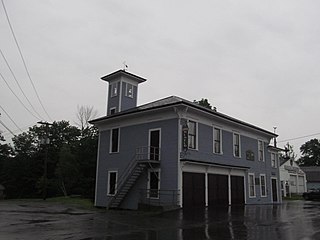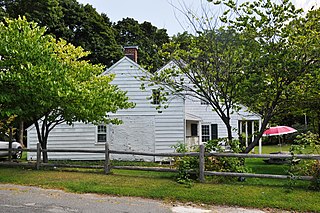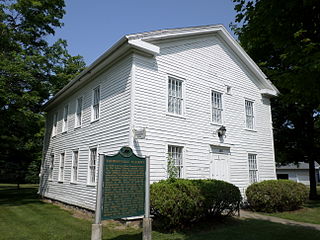
The Holland Land Office building is located on West Main Street in downtown Batavia, New York, United States. It is a stone building designed by surveyor Joseph Ellicott and erected in the 1810s.

The Lord & Burnham Building, located at the corner of Main and Astor Streets in Irvington, New York, United States, is a brick building in the Queen Anne architectural style built in the 1880s. In 1999 it was listed on the National Register of Historic Places, and was added as a contributing property to the Irvington Historic District in 2014.

The Old Faithful Historic District in Yellowstone National Park comprises the built-up portion of the Upper Geyser Basin surrounding the Old Faithful Inn and Old Faithful Geyser. It includes the Old Faithful Inn, designed by Robert Reamer and is itself a National Historic Landmark, the upper and lower Hamilton's Stores, the Old Faithful Lodge, designed by Gilbert Stanley Underwood, the Old Faithful Snow Lodge, and a variety of supporting buildings. The Old Faithful Historic District itself lies on the 140-mile Grand Loop Road Historic District.

The Monson Historical Society Museum is located on Main Street in the center of Monson, Maine. It is housed in a former municipal building, built in 1889 to house firefighting equipment and a fraternal lodge, and listed on the National Register of Historic Places as Monson Engine House (Former) on August 5, 2005, as one of a small number of surviving 19th-century fire stations in rural interior Maine. The museum is open on Saturdays in the summer, showing items of local historical interest.

The Hammond House is located on Grasslands Road in the Eastview section of the town of Mount Pleasant, New York, United States. It is a wooden building whose oldest part dates to the 1720s, with latter additions during the 19th century. In 1980 it was added to the National Register of Historic Places.

The North Grove Street Historic District is located along the north end of that street in Tarrytown, New York, United States. It consists of five mid-19th century residences, on both sides of the street, and a carriage barn. In 1979 it was listed on the National Register of Historic Places.

The former Washington School is located on Croton Avenue in the village of Ossining, New York, United States. It was built in 1907 in the Beaux-Arts style, one of two in the village to use it. It was added to the National Register of Historic Places in 1987.

The Ault Store is a historic commercial building in Dundas, Minnesota, United States. The building was placed on the National Register of Historic Places (NRHP) on April 6, 1982.

The Vermontville Academy, also known as the First Congregational Chapel, is a building in Vermontville, Michigan, located at 106 North Main Street. It was listed on the National Register of Historic Places in 1972, and is part of the Historic American Buildings Survey. It now serves as the Vermontville Historical Museum.

The Sage Library is a historical structure located on 100 E. Midland St in Bay City, Michigan. The library had its grand opening on January 16, 1884 and was constructed by Henry W. Sage as a gift to Bay City. It is operated as a public library by the Bay County Library System. The building was listed on the National Register of Historic Places in 1979. It is the oldest continually operated library building in the state of Michigan.
The Anderson Brothers Store is a historic general store building at 280 Main Street in Stockholm, Maine, United States. Built in 1901, this 1+1⁄2-story wood-frame structure was the town's first general store, and is its only historic retail building. It operated until the 1950s, and now houses the Stockholm Historical Society's museum.

The Chandler-Parsons Blacksmith Shop, now the Blacksmith Shop Museum, is a historic blacksmith shop at 107 Dawes Road in Dover-Foxcroft, Maine. Believed to be built in the early 1860s, it is one of a very small number of relatively unaltered rural 19th-century blacksmithies in the state. It is owned and operated by the local historical society as a museum, and was listed on the National Register of Historic Places in 1989.

The first jail was built in 1837 of 14 inches (36 cm) square logs. It was two stories tall with a trap door from the second story floor to access the ground floor. The next jail was made of brick. Like the first jail, it was located on Courthouse Square. By 1869 this second structure was in serious need of repair. Frequent jail breaks from the second jail, led the county to hire George Garnsey of Chicago to design a new jail. The most notable jailbreak resulted when prisoners pushed bricks out of the wall.

The B.H. and J.H.H. Van Spanckeren Row Houses, also known as the Wyatt Earp House and the Pella Historical Society, is an historic building located in Pella, Iowa, United States. The Van Spanckerens were brothers who, along with their mother, Catharina Reerink Van Spanckeren and two other siblings emigrated from the Netherlands in the 1840s. Catharina bought property in Pella in 1849, which she divided into three parcels and sold to her three sons. B.H. and J.H.H. built this rowhouse sometime between 1855 and 1860, while the third brother sold his parcel in 1864. The shared wall of this two-story brick house is on the property line. Both houses were divided into two units. In 505 both units were separate apartments. American frontier lawman Wyatt Earp spent 14 years of his boyhood in this row house. In 507, the upstairs was an apartment while the downstairs housed J.H.H.'s general store. Both houses were owned by separate owners until 1966.

The Millington Bank Building is a commercial building located at 8534 State Street in Millington, Michigan. It was listed on the National Register of Historic Places in 1995. It now houses the house the Millington-Arbela Historical Society's museum.

The Bell-Spalding House, also known as the Tuomy House, is a single-family home located at 2117 Washtenaw Avenue in Ann Arbor, Michigan. It was listed on the National Register of Historic Places in 1990.

The Charles H. Calkins House, originally built as a single-family home, is located at 127 East 1st Street in Perry, Michigan. It now houses the Calkins-McQueen Museum, and was listed on the National Register of Historic Places in 1978.

The James M. Jameson Farm is a farmstead located at 10220 North Parma Road near Springport, Michigan. It was listed on the National Register of Historic Places in 1980.

The Benjamin and Maria (Ogden) Drake Farm, also known as the Drake Farmstead, is a farmstead located at 927 North Drake Road in Kalamazoo, Michigan. It was listed on the National Register of Historic Places in 2012.1

The Daniel Dayton House, also known as Ravine House, is a historic stagecoach inn in Harmony Township, Minnesota, United States. It was built in 1857 as an overnight stop on the Dubuque–St. Paul Stage Road, a frontier mail and stagecoach route through Iowa and Minnesota. The house was listed on the National Register of Historic Places in 1977 for its local significance in the themes of architecture, exploration/settlement, and transportation. It was nominated for being one of Minnesota's few surviving stagecoach inns, for its stone architecture, and for its association with the pioneer era of Harmony Township.





















